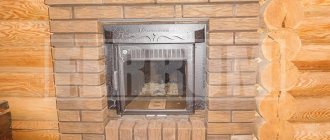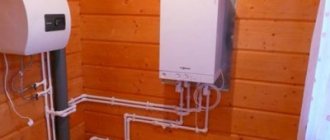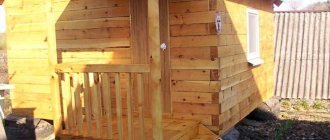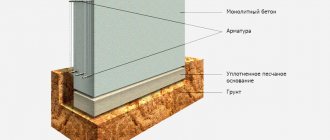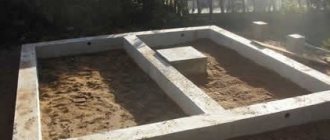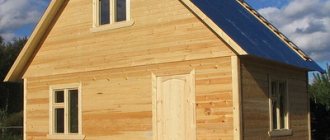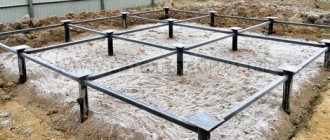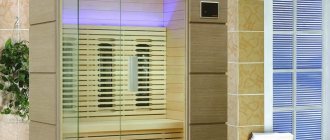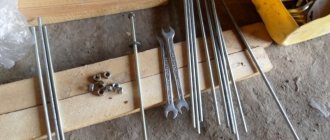Private developers often try to speed up the construction of buildings on their sites, so they often use unconventional construction technologies. One of them includes a foundation made of barrels, which involves a formless version of the foundation for the structure. The result is point supports - buried or installed on sand pads directly on the ground surface. This method has many fans and opponents, each of which has its own arguments and assumptions. But the fact remains that a method of constructing a foundation from concrete-filled barrels exists, although it has some limitations.
Features of folk technology
To construct the foundation, metal barrels are used with the lid cut off, and often the bottom, resulting in a kind of formwork in the form of a cylindrical casing-shell. Standard products have:
- volume – 200 liters;
- diameter – 60cm;
- height – 85cm;
- wall thickness is about 1mm.
Prepared barrels are installed at the corners of the structure and in the spaces between them, which depends on the size of the structure in plan. Based on the type of soil and its freezing mark, the foundation is buried 30-50 cm or more, or left on the surface of the earth, after which the metal casings are filled with concrete. If necessary, reinforcing mesh is placed in the barrels in advance to simplify the adhesion of the pillars to the grillage. The result is a simple DIY foundation that can support small structures:
- country house;
- summer kitchen;
- winter gazebos;
- baths, etc.
Selecting a concrete strength grade for pouring (concreting) the foundation of a private house
To fill the foundation of a private house, a concrete solution of at least grade M200 is used (see the article “types of concrete”), and when building stone or block buildings, grade M250-M300 is used. However, when using these grades for the foundation, waterproofing is necessary because these types of concrete solutions are not waterproof.
Many experts recommend immediately using special hydraulic concrete mixtures of grades M400 and higher. However, there may be dangers here: it is very difficult for a non-specialist to determine the brand of concrete by sight, and they can bring you anything, so first of all, upon delivery, ask for a certificate confirming the authenticity of the concrete brand and its compliance with TU and GOST.
The poor quality of the concrete mixture can be determined only after 28 days, when obvious defects appear on the hardened foundation, however, the quality of fresh concrete can be determined by appearance.
An obvious defect is the consistency of the solution, that is, the ratio of cement and filler: the formation of voids during pouring, which must be filled with dry filler, indicates poor quality of the concrete mixture.
Crushed stone husks are also considered defective: when mixed in a mixer, crushed stone peels off - this is a defect. Suppliers may try to explain to you that this is an intended screening, but it is not included in the formulation of medium fraction concrete.
Of course, it is necessary to check the delivered concrete mixture for radioactivity. According to the first class of radioactivity, the solution should not exceed 370 bq/kg; higher values mean that the unscrupulous supplier contains crushed stone in the concrete that is not intended for residential construction; such crushed stone can only be used for railway construction.
Keep in mind that standard background radiation dosimeters have readings in microroentgen/hour, and not in bq/kg, so you need to prepare in advance and be able to translate the readings.
Positive and negative sides of the “barrel” foundation
One of the advantages of the technology of constructing a foundation from metal barrels filled with concrete is the needlessness of constructing formwork. Firstly, this significantly saves time, and secondly, it does not require special qualifications of workers. But, unfortunately, there are many more disadvantages to this type of work. In particular, they relate to the effectiveness of the method used.
Few households have the number of 200-liter or other metal barrels needed to construct a foundation, so they will have to be purchased. Such a purchase can be much more expensive than the cost of boards, fasteners and other materials necessary for installing the formwork. Also, in most cases, it is irrational to overuse concrete when filling the required volume of metal shells, especially in the case when it is necessary to deepen the foundation by more than a meter due to the low freezing horizon of the soil. In this case, you will have to install not one, but two barrels in height. Although, under small structures with deep groundwater, it is often practiced to install a sand cushion instead of additional deepening, and on rocky soils the barrels are left directly on the surface.
Difficult clay soils and high groundwater levels require laying the foundation below the freezing level, otherwise the swelling forces may be higher than the foundation pressure, which will lead to the lifting of the barrels and distortion of the structure.
It is also necessary to understand that moisture-saturated soils after thawing often cause changes in the location and subsidence of metal foundation pillars if the deepening, backfilling or sand cushion was carried out incorrectly.
Video on how to make a foundation for a bathhouse from scratch step by step
The quality of the foundation largely determines the service life and characteristics of the structure being built. A minor violation of technology can create serious difficulties not only at the construction stage, but also in the subsequent operation of the bathhouse. Watch the video, which explains in detail how to make a foundation correctly.
Currently, various building materials are available that allow you to build a foundation for a bathhouse in different ways. Choose the appropriate option, and then you will have a comfortable place where you can wash and have a good rest.
Stages of work
The top of the barrel must be removed. The removable lid is simply removed, and the circle is completely cut off from the closed container. You can leave the bottom of the barrel; there is no need to get rid of it. The prepared casings are installed on a prepared, leveled base at the corners of the building, at the junction of load-bearing walls, and, if necessary, in the spaces between already installed foundation supports.
First, markings are made by stretching cords around the perimeter of the structure. They will serve as a guide for correctly determining the location of the barrels in the plan. Separately, under each container, a small pit is dug to the depth of the underground structure, to the bottom of which, in stages:
- a leveling sand cushion 10-15 cm thick is added;
- roofing felt is laid in 1-2 layers as waterproofing;
- metal shells lubricated with waste oil are installed.
After backfilling the pits with a sand mixture with layer-by-layer wetting and compaction, they begin to fill the containers with concrete. The reinforcing mesh provided in the design is laid and fixed in metal shells in advance. Each barrel should be filled with the solution at a time, otherwise uneven setting can lead to delamination of the concrete monolith, which is unacceptable. Work on pouring the foundation is most often done manually, since concrete pumps are quite rare in private farms, and installing special gutters is not always a rational solution.
Experts recommend organizing the construction process in such a way that the “barrel” foundation does not remain unloaded during the winter period. Otherwise, after the soil thaws, there will be a possibility that the position of the filled containers will change.
Waterproofing is laid on top of the concrete barrels, protecting the walls from moisture penetration into the ground part of the building. For this, traditional roofing felt laid in two layers is most often used. The finished foundation is tied with a reinforced concrete grillage or a frame crown, if we are talking about building a bathhouse from a log house, for example.
Reducing freezing depth
The most important factors when building a foundation are the depth of soil freezing and the composition of this same soil at the construction site. And that's why.
Therefore, when building on such soils, the base of the foundation is buried below the freezing mark so that the foundation rests on a reliable foundation, which lies quite deep and does not freeze in winter. If this is not taken into account, the result of construction will be cracked walls, destruction of structures and the need for labor-intensive repairs of the entire structure.
The heaving of soils can be determined based on an independent study of soils on the site and the presence of moisture at different times of the year. So, for example, if the groundwater level rises only in the spring, this is not so scary, since it will not lead to freezing of the foundation. Typically, in such areas, puddles and mud appear only during the spring snowmelt. If throughout the year the soil on the site has fairly high humidity, then this is a bad sign.
In addition, you should pay attention to the composition of the soil, which can be visually determined by the twisting of a ring from a small piece of soil, from which they roll a “sausage” and then try to bend a ring out of it. Clay and loamy soils roll easily and bend into a ring almost without breaking up. It will not be possible to roll sandy soil - it will crumble into grains of sand.
Having determined the composition of the soil, a decision is made on the depth of the foundation base.
To avoid the forces of frost heaving when building on clay and loamy soils, you can slightly reduce the depth of their freezing. For example, ordinary paving around the perimeter of a building can reduce the depth of freezing by the thickness of the bulk soil.
If you plan to build in an area with heavy snowfall and a thick layer of snow in winter, then you can reduce the calculated freezing depth in accordance with the given schedule.
Blind area
The most important structural element of any building and ancillary building is the blind area. Its functions include protecting the foundation from erosion during rain, melting snow or floods. A waterproof coating is placed around the perimeter of the entire structure with a slope directed from the base. The width and slope of the blind area depends on several factors, among which the most important are:
- soil type;
- removal of roof eaves.
First of all, the future contours of the blind area are outlined locally - both external and internal. The first, as a rule, runs at a distance of 0.9-1 meter from the outer surface of the barrels, and the second - along their central axis. It should be noted that the outer line may be located somewhat closer to the tanks, depending on the ground conditions and the overall design of the building. Within the intended boundaries, a layer of earth approximately equal to the size of a shovel is selected, and an edged board is laid on both sides as formwork. A 10-centimeter layer of sand is poured into the resulting recess, which is compacted after moistening. Next, lay out a 2-3 cm layer of crushed stone and compact it as well.
Perpendicular to the blind area, every 1.8-2 meters along the length, thin wooden slats are placed edgewise, which are necessary for organizing expansion joints. They protect the concrete screed from destruction in the event of temperature changes or soil subsidence.
The final stage will be laying a concrete layer approximately 4-5 cm thick, leveling and forming a slope away from the building. Subsequently, ironing is carried out or the finished surface is impregnated with polymer compounds that prevent the formation of microcracks on the screed or any other defects that allow moisture to penetrate into the concrete layer. It should be noted that the screed can additionally be finished with tiles or stone, but this depends on the taste of the owner.
ABOUT ME
I am a builder with over 20 years of experience and have done foundations in many different ways. Now I live in a village where I have my own small farm with chickens and fish in my own pond .
I’m resting, although not – I’m writing articles for you, and this is also work.
By the way, you can find me on Youtube
or write on
VKontakte.
Surely the thought of building a house and inexpensively came to mind, so this foundation is just inexpensive and durable. The houses stood for more than 10 years and no questions arose.
Everyone just shows how to build, but not everyone can show their work in 10-30 years. For your attention, I am exactly that person..))
Site preparation.
First, the site is cleared of construction debris. Next, make the markings.
To do this you need to take:
- Reinforcement or pegs;
- Rope;
- Roulette;
- Square with right angle;
- Level and clothespins.
You need to hammer in a peg and measure the length of one wall. Secure with a second peg. Then pull the rope for the perpendicular walls. Angles are checked.
Everything is fixed with clothespins. Then measure the distance between the diagonals.
The pegs must be driven in firmly and the rope must be pulled tightly. The result is a rectangle, the diagonals of which should be equal. Deviations cannot be more than 2 cm.
Preparation of the solution
Material selection
The preparation of concrete must be approached with particular responsibility, since the reliability of the entire structure will depend on this. The composition of the solution and its brand depend on the type of structure. For example, for small structures made of lightweight materials, lightweight concrete can be used, which will save money and at the same time make the structure warmer.
However, not all materials are suitable even for light structures; for example, it is impossible to build a foundation from foam concrete due to its low strength and hygroscopicity. Such material will absorb moisture and simply crack when frozen.
Also, you should not try to make a foundation from polystyrene concrete, since its strength will also not be enough, however, this material can be used to build a base. This option is especially common when building houses from aerated concrete.
Structure of expanded clay concrete
But a foundation made of expanded clay concrete for light construction is quite acceptable, since expanded clay itself is a fairly durable material. When the temperature changes, expanded clay concrete does not expand or contract, which ensures a constant shape. In addition, expanded clay concrete has good wear resistance.
But, of course, the most durable is traditional concrete, which can be used for any buildings made of any materials. The only thing is that it must be prepared correctly, since all the basic characteristics of concrete depend on this. Therefore, we will consider this process in more detail.
Cement M500
Preparation of concrete
To prepare concrete you will need the following materials:
| Cement | Most often, cement of the M400 or M500 grade is used for the construction of a concrete foundation. Of course, the price of M500 is slightly higher, but such cement allows you to create more durable concrete. |
| Sand | Purified sand should be used to build the foundation. The fraction sizes should be in the range of 1.2-3.5 mm. |
| Crushed stone | Large filler must also be cleaned of clay or other contaminants. The particle size of crushed stone or gravel should be within 1-8 cm. |
| Water | Like all other ingredients, the water must be clean. |
The most optimal concrete for the foundation is M350. To obtain it, components are used in the following proportions:
| Cement grade M500 | One part |
| Sand | Two parts |
| Crushed stone or gravel | 4 parts |
| Water | ½ part |
Preparation of the solution
The instructions look like this:
- First of all, you need to mix the dry ingredients - cement and sand..
- Then water is added to the composition and the solution is thoroughly mixed . You can also add a plasticizer to improve the characteristics of the material or other additives as necessary.
- After obtaining a homogeneous solution, crushed stone, previously moistened with water, is added to it and mixed thoroughly.
This completes the concrete making process. It must be said that sometimes a foundation is built from sand concrete. In this case, crushed stone is not added to the composition. Ready-made dry sand concrete mixture can be purchased at construction stores.
